You’re hosting a dinner party, and as you reach for your favourite plate, it slips from your hands.
Will it shatter into a thousand pieces, or will it bounce harmlessly off the floor? This moment of panic perfectly captures the dinnerware dilemma that haunts every home.
The choice between melamine vs glass dinnerware has been puzzling families everywhere.
Both materials promise different things: one offers unbreakable convenience, whilst the other delivers timeless elegance.
Yet beneath their surface appeal lies a complex web of safety concerns, durability questions, and lifestyle considerations that every discerning homeowner must navigate.
But which one truly deserves a place on your table? Let’s find out!
MELAMINE DINNERWARE MANUFACTURING PROCESS
The manufacturing process involves heating melamine powder and formaldehyde under extreme pressure.
This creates a hard, heat-resistant plastic that can be moulded into countless shapes and designs.
Manufacturers often add decorative elements during this process, creating patterns that rival traditional ceramics.
Key Characteristics
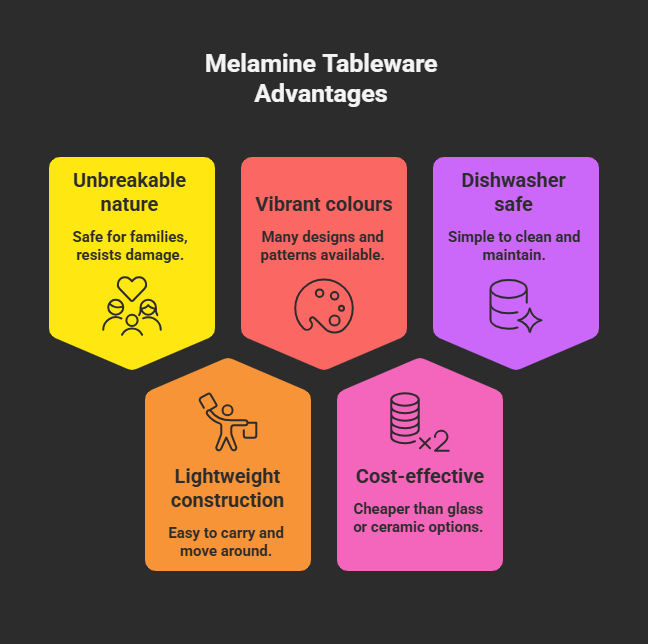
Melamine dinnerware, sometimes called melaware – offers several distinctive features:
- Unbreakable nature: Perfect for families with children
- Lightweight construction: Easy to handle and transport
- Vibrant colours: Available in countless designs and patterns
- Cost-effective: More affordable than glass alternatives
- Dishwasher safe: Easy maintenance and cleaning
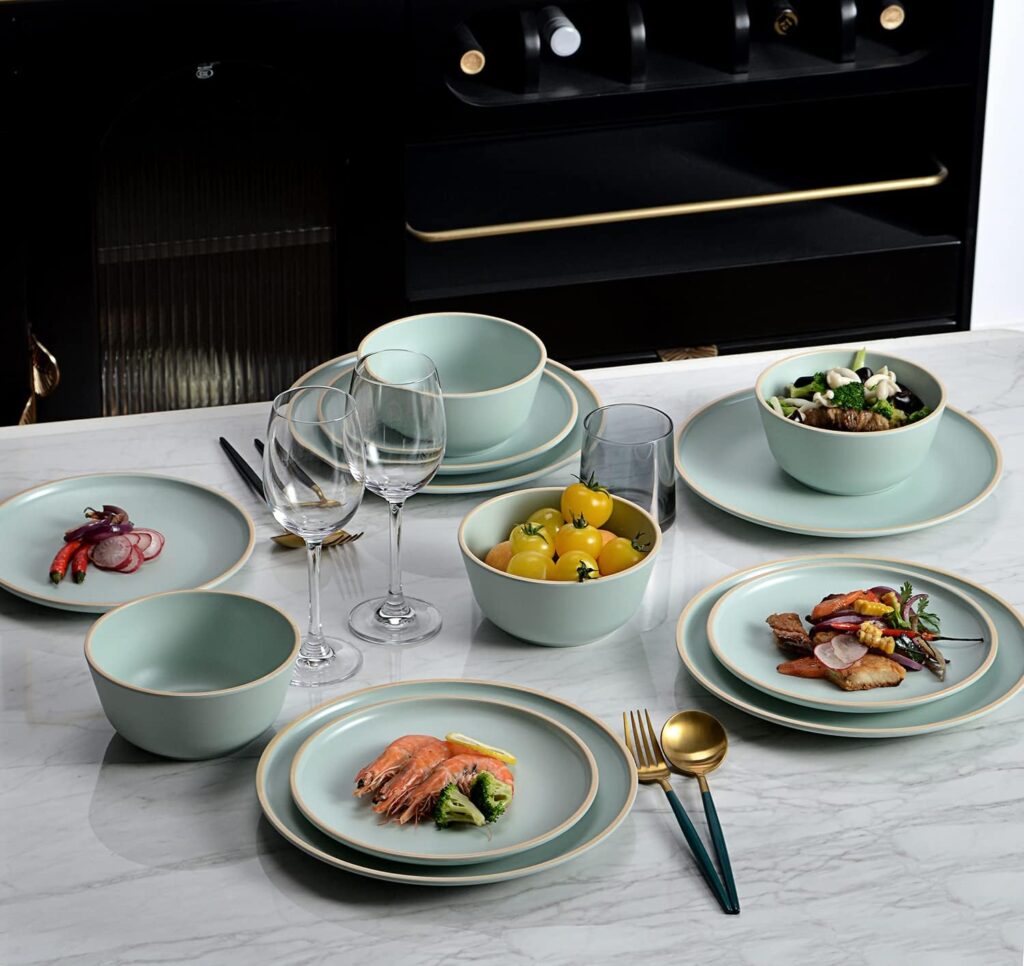
However, not everything glitters in the melamine world. These plates and bowls come with specific limitations that every buyer should understand before making their choice.
WHAT IS GLASS DINNERWARE?
Glass dinnerware represents centuries of refined craftsmanship. From the delicate crystal goblets of Victorian dining rooms to today’s tempered glass plates, this material has consistently delivered elegance and functionality.
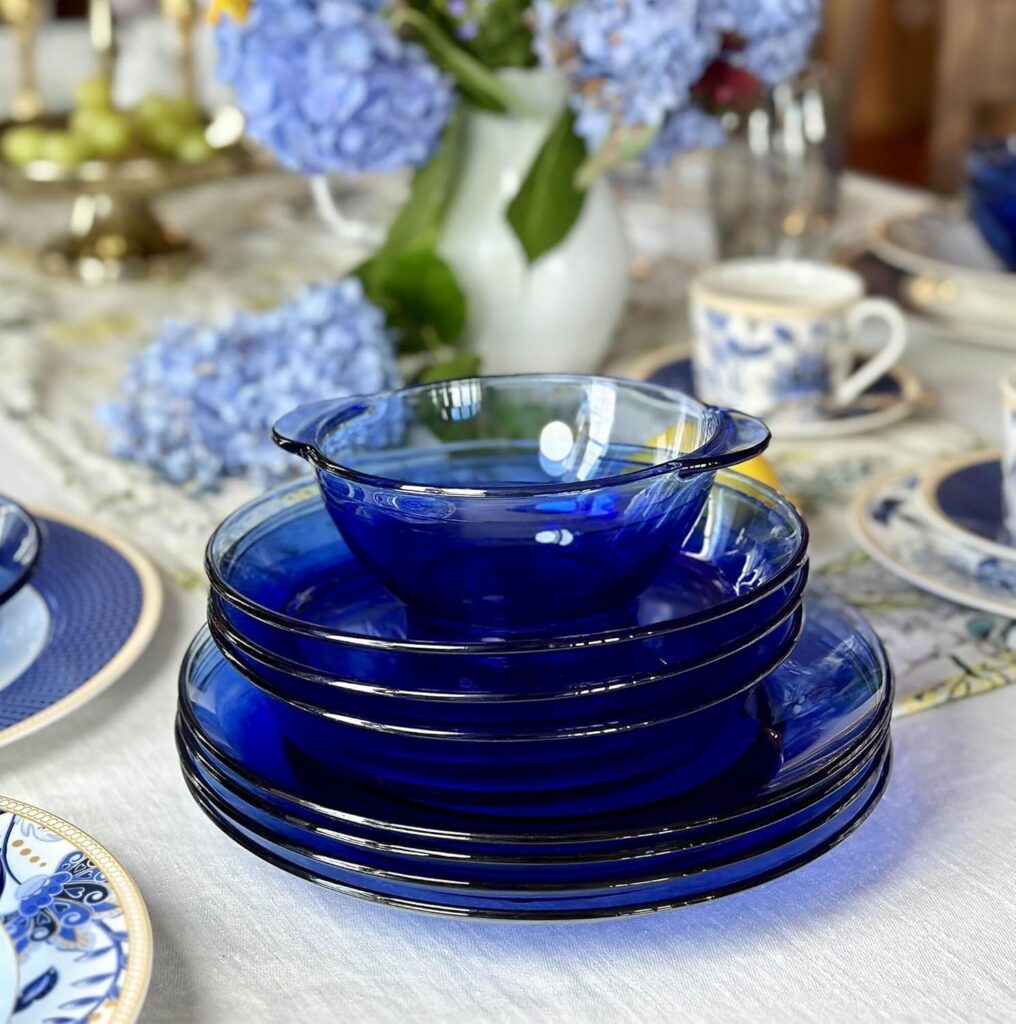
Modern glass dinnerware typically uses tempered glass or borosilicate glass. These materials undergo special heating and cooling processes that increase their strength and thermal resistance.
The result is tableware that can withstand daily use whilst maintaining its pristine appearance.
The Manufacturing Process
Glass dinnerware production involves melting silica sand, soda ash, and limestone at temperatures exceeding 1,500°C.
The molten glass is then shaped using various techniques, including pressing, blowing, or moulding.
Finally, the pieces undergo tempering – a process that makes them significantly stronger than regular glass.
Distinguished Features
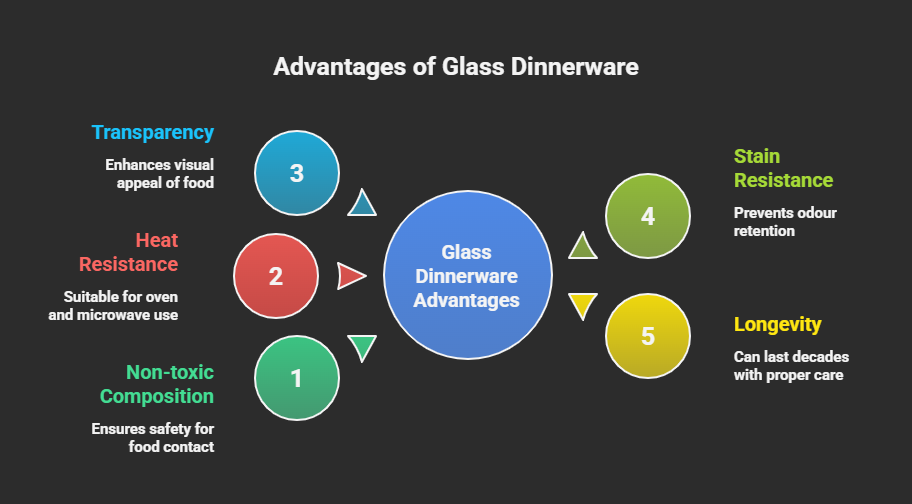
Glass dinnerware offers unique advantages:
- Non-toxic composition: Completely safe for food contact
- Heat resistance: Suitable for oven and microwave use
- Transparency: Allows visual appeal of food presentation
- Stain resistance: Non-porous surface prevents odour retention
- Longevity: Can last decades with proper care
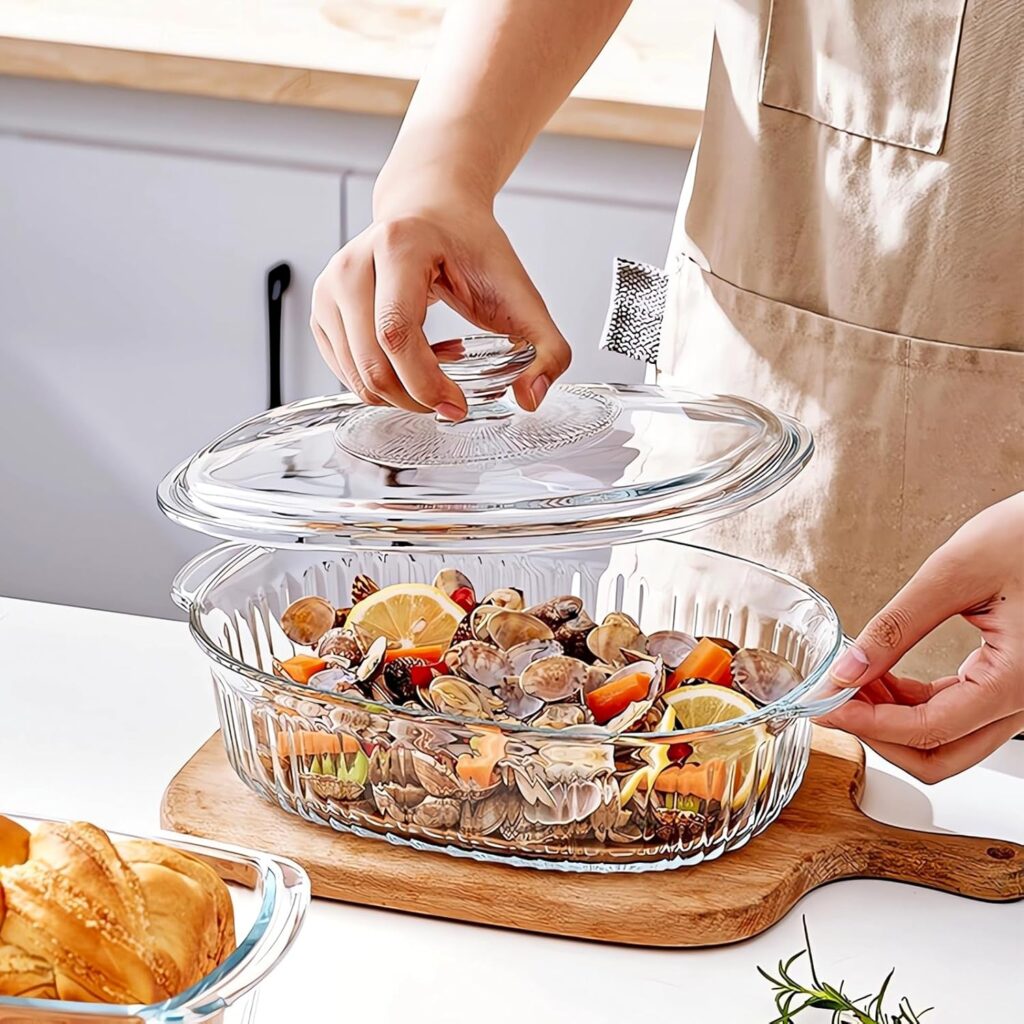
Yet glass isn’t without its challenges. Understanding these limitations helps you make an informed decision about your tableware investment.
MELAMINE VS GLASS DINNERWARE: THE ULTIMATE COMPARISON
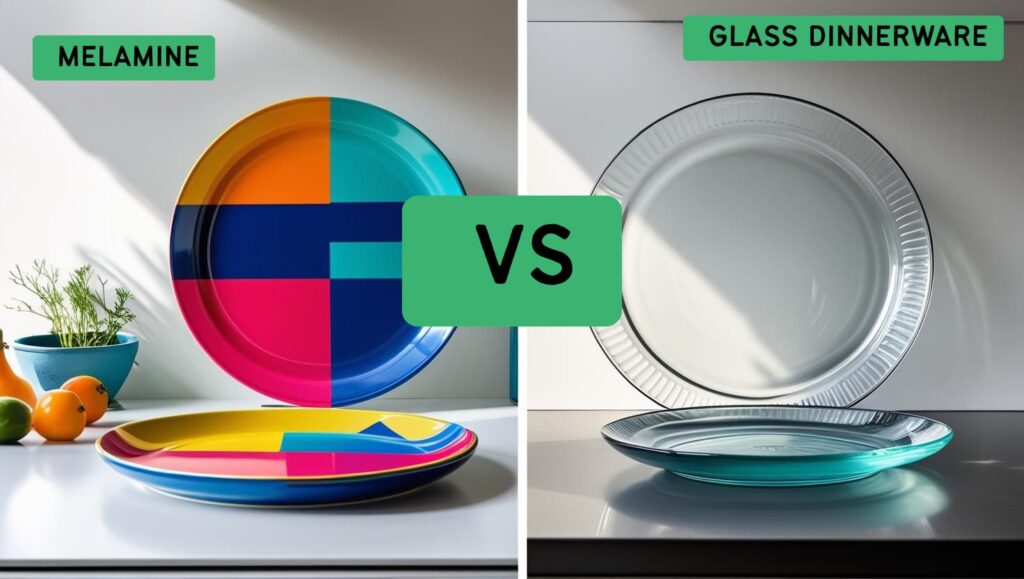
Safety and Health Considerations
The safety of dinnerware materials represents the most critical factor in any comparison. Here’s where the differences become stark and concerning.
Glass dinnerware emerges as the clear winner in safety. Its inert nature means it won’t leach chemicals into your food, regardless of temperature or acidity.
Glass remains completely non-toxic dinnerware, making it ideal for health-conscious households.
Melamine dinnerware, however, presents several safety concerns:
- Chemical leaching: Melamine can release harmful chemicals, especially when heated
- Microwave restrictions: Never microwave melamine plates
- Temperature limitations: Avoid hot foods above 70°C
- Acidic food reactions: Citrus and tomato-based foods may cause more leaching
The FDA originally set the TDI for melamine at 0.63 mg per kg of body weight per day for foods other than infant formula.
For infant formula, the FDA has recommended a zero-tolerance policy, meaning any detectable amount is considered unacceptable due to the vulnerability of infants.
While International bodies such as the World Health Organization (WHO) on Melamine exposure have set a lower TDI of 0.2 mg/kg body weight per day.
Durability and Breakage Resistance
When it comes to breakage resistant dishes, melamine takes the crown. This material can withstand drops, knocks, and rough handling that would destroy glass dinnerware instantly.
Melamine advantages:
- Virtually unbreakable under normal use
- Ideal for outdoor dinnerware options
- Perfect for children’s meals
- Survives camping trips and picnics
Glass limitations:
- Susceptible to thermal shock
- Can shatter with sudden temperature changes
- Requires careful handling and storage
- Replacement costs add up over time
However, durability extends beyond mere breakage resistance. Glass maintains its appearance indefinitely, whilst melamine may show scratches, stains, and wear over time.
Heat Resistance and Microwave Safety
Heat resistant dinnerware becomes crucial for modern cooking habits. Glass excels in this category, offering versatility that melamine simply cannot match.
Glass capabilities:
- Microwave safe dinnerware
- Oven-safe up to 220°C
- Dishwasher safe at any temperature
- Handles thermal shock better than expected
Melamine limitations:
- Never microwave – chemicals can leach
- Maximum temperature: 70°C
- Dishwasher safe only on gentle cycles
- Hot foods may cause warping
Cost and Value Analysis
Budget-friendly dinnerware often drives initial purchase decisions. Melamine wins on upfront costs, but the long-term value equation becomes more complex.
| Factor | Melamine | Glass |
| Initial Cost | Affordable | Medium – High |
| Replacement Frequency | 2-3 years | 8+ years (depends on use and care) |
| Long-term Value | Moderate | Excellent |
| Resale Value | Low | Moderate |
The calculation changes when you factor in replacement costs. Glass dinnerware, despite higher initial investment, often provides better value over time.
Environmental Impact
Eco-friendly dinnerware considerations increasingly influence purchasing decisions. Glass demonstrates clear environmental advantages throughout its lifecycle.
Glass benefits:
- 100% recyclable
- Made from abundant natural materials
- No harmful chemicals in production
Melamine concerns:
- Plastic-based production
- Not easily recyclable
- Potential chemical emissions
- Contributes to plastic waste
Glass Dinnerware Concerns:
- Not biodegradable (broken or not)
WHEN TO CHOOSE MELAMINE TABLEWARE
Perfect Scenarios:
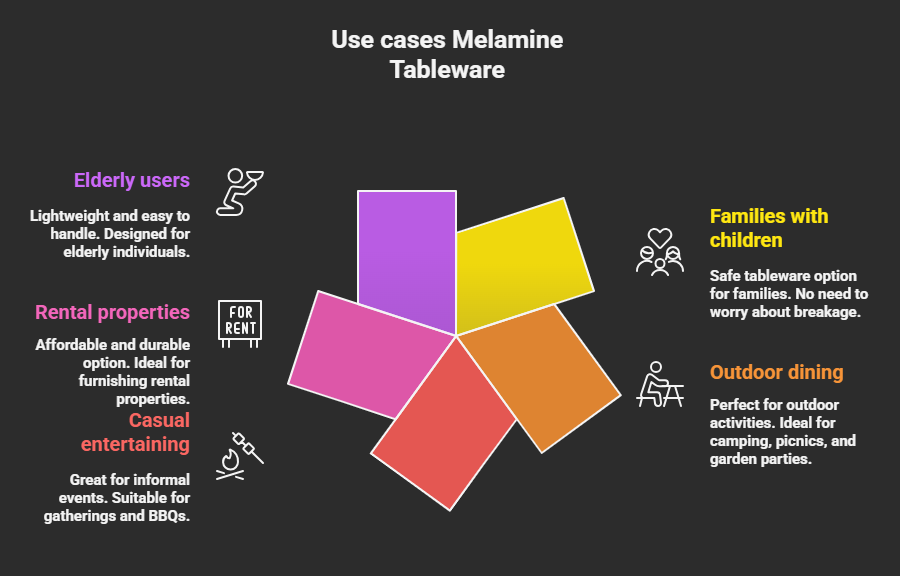
Melamine dinnerware shines in specific situations where its unique properties become valuable assets rather than limitations.
Ideal for:
- Families with young children: No fear of breakage
- Outdoor dining: Camping, picnics, and garden parties
- Casual entertaining: Informal gatherings and BBQs
- Rental properties: Affordable and durable
- Elderly users: Lightweight and easy to handle
Lifestyle Matching:
Consider melamine when convenience trumps other factors. Its lightweight dinnerware nature makes it perfect for people who prioritise practicality over prestige.
WHEN TO CHOOSE GLASS DINNERWARE
Optimal Conditions:
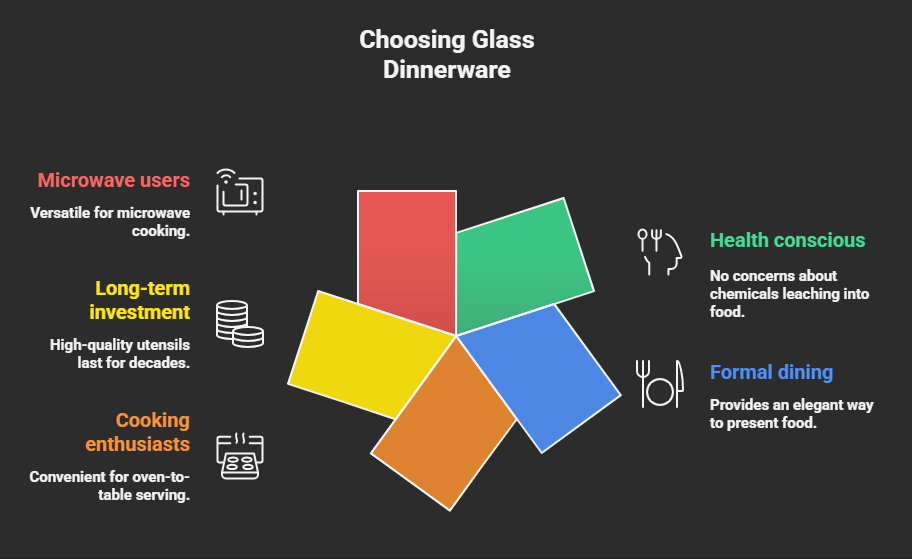
Glass dinnerware excels when elegance, safety, and versatility take precedence over durability concerns.
Perfect for:
- Health-conscious households: Zero chemical concerns
- Formal dining: elegant presentation
- Cooking enthusiasts: Oven-to-table convenience (Depends on brand quality & specifications)
- Long-term investment: Quality that lasts decades
- Microwave users: Complete cooking versatility
The Sophisticated Choice:
Glass appeals to those who view dinnerware as an extension of their personal style. Its transparency showcases food beautifully like white tableware whilst maintaining absolute safety standards.
GLASS VS CERAMIC: ADDITIONAL CONSIDERATIONS
The Third Option
When comparing glass vs ceramic dinnerware, another compelling option emerges.
Ceramic offers middle-ground benefits that might influence your melamine versus glass decision.
Ceramic advantages:
- Better heat retention than glass
- More durable than glass
- Lighter weight than glass
- Classic beautiful appeal
Ceramic limitations:
- More expensive than melamine
- Still breakable (though less than glass)
- Heavier than melamine
- Potential lead concerns in older pieces or low quality.
Decision Framework
Consider ceramic when you want the elegance of glass with slightly better durability, whilst still maintaining the safety benefits of non-toxic dinnerware.
EXPERT TIPS FOR DINNERWARE SELECTION
Making the Right Choice
Selecting the perfect dinnerware requires balancing multiple factors against your specific needs and lifestyle.
Key considerations:
- Household composition: Children require different considerations than adults
- Entertaining style: Formal versus casual dining preferences
- Storage space: Weight and stackability matter
- Maintenance preferences: Time available for careful handling
- Budget constraints: Initial cost versus long-term value
Professional Recommendations
Interior designers consistently recommend investing in quality glass dinnerware for primary dining, whilst keeping melamine as backup for casual use or outdoor dining.
Maintenance Mastery
Glass care:
- Hand wash delicate pieces
- Avoid extreme temperature changes
- Store with padding between pieces
- Replace damaged items immediately
Melamine care:
- Use gentle dishwasher cycles
- Avoid abrasive cleaners
- Replace when scratched or stained.
THE VERDICT: MAKING YOUR CHOICE
Final Recommendations:
The melamine vs glass dinnerware comparison ultimately depends on your priorities and lifestyle.
Neither option represents a universal solution, but understanding their strengths helps you make an informed decision.
Choose melamine when:
- Safety from breakage outweighs chemical concerns
- Budget constraints limit options
- Outdoor dining represents primary use
- Children’s safety requires unbreakable dishes
Choose glass when:
- Health and safety take absolute priority
- Cooking versatility matters
- Long-term value trumps initial cost
- Elegant presentation enhances your dining experience
The Hybrid Approach
Many households benefit from owning both materials. Use glass for everyday dining and special occasions, whilst keeping melamine for outdoor use, children’s meals, and casual entertaining.
CAN GLASS DINNERWARE GO IN THE MICROWAVE?
Yes, most glass dinnerware is microwave safe. However, always check manufacturer guidelines and avoid sudden temperature changes that might cause thermal shock.
IS MELAMINE OR GLASS BETTER FOR CHILDREN?
For pure safety from breakage, melamine wins. However, glass offers better food safety with no chemical concerns. Many parents choose melamine for young children and transition to glass as children mature.
HOW DO I KNOW IF MY DINNERWARE IS MELAMINE OR CERAMIC?
Melamine feels lighter and warmer to the touch than ceramic. It also produces a different sound when tapped – less resonant than ceramic or glass.
CONCLUSION
The choice between melamine and glass dinnerware reflects more than mere material preference, it represents a lifestyle decision that impacts your family’s health, budget, and daily dining experience.
Glass emerges as the superior choice for those prioritising safety, versatility, and long-term value.
Its non-toxic composition and heat resistance make it ideal for health-conscious households willing to handle with care.
Melamine serves specific needs brilliantly – particularly for families with young children, outdoor enthusiasts, and budget-conscious buyers who prioritise durability over other factors.
The sophisticated approach involves recognising that you don’t need to choose just one.
Many households successfully incorporate both materials, using each where it performs best.
What’s your dinnerware story? Share your experiences and preferences in the comments below – we’d love to hear which material has won your heart and why.